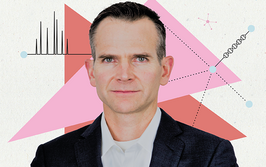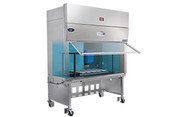
Neil Kelleher: The Human Proteoform Project Could Transform Healthcare
We’re 20-30 years away from inventing and integrating next-generation proteomics technologies into healthcare – if we start the Human Proteoform Project now
| 10 min read | Interview

Neil Kelleher
Imagine a world where a simple drop of blood, a finger-prick, or a wearable sensor provides a continuous readout of your biological health – without having to visit the hospital. Where AI-powered tools analyze not just your DNA, but your entire molecular profile, to predict risks, guide personalized treatments, and even prevent diseases from developing at all. What would it take to make this vision a reality? What role will analytical science play? And can we get there by 2050?
Here, as part of a series of articles tackling these important questions, we speak with Neil Kelleher – Walter and Mary E. Glass Professor of Molecular Biosciences; Director, Northwestern Proteomics; Director, Chemistry of Life Processes Institute; Northwestern University, USA – who believes the Human Proteoform Project is key to manifesting a precision medicine future.
Has the Human Genome Project lived up to the early expectations?
The Human Genome Project moved the needle in all sorts of ways. At the time, launching a ~$3.5 billion, 10-year project was highly controversial, whether you were talking to scientists, science enthusiasts, or the general public. It wasn’t a universally agreed-upon idea – there was a lot of debate about whether we should do it.
But now, more than 25 years later, I think it has proven its value. The advancements in the research and medical community that have stemmed from the Human Genome Project are undeniable. Today, when people talk about genomics, they have a much deeper understanding of what it means. Cancer genome sequencing, genetic assessments, and personalized medicine have all evolved far beyond where they were before the project.
But is it the whole precision medicine picture… ?
No, I think there’s still a significant gap between DNA-level biology and how diseases actually manifest. Some conditions – monogenic diseases like sickle cell anemia – are relatively straightforward in terms of their genetic basis. We’re already seeing FDA-approved treatments targeting these types of diseases. But complex diseases? Well, they’re complex for a reason. There’s a huge gap between genetic information and how traits and diseases actually express themselves.
Many of us in the proteomics community – whether protein biochemists or geneticists who have pivoted toward protein-level biology – recognize this gap. There’s a growing consensus that we need a systematic, standardized approach to proteomics, similar to what was done to help build genomics on a firm foundation. Proteins are distinct from other molecular players like metabolites or RNA, and yet, unlike genomics, we still lack a fully standardized framework for understanding them at the molecular level – which means a reference set of proteoforms and an ability to read them out at scale.
What we need is regularization – a structured, standardized approach to defining proteoforms: the precise molecular versions of proteins that stem from our 20,300 genes. If we start by defining these proteoforms, we can then develop cost-effective technologies – similar to next-generation sequencing – to track proteins with complete molecular specificity. That means we’d finally be able to see, at the protein level, what drugs are doing and how diseases are progressing in a way that genomics alone cannot provide.
That’s the next step – some would say the obvious next step. We need a Genome Project for proteins: a high-resolution reference proteome – not just fragmented glimpses where different technologies measure partial sequences of proteins, creating ambiguities and inference problems. Incomplete molecular information leads to knowledge gaps. And that’s what we aim to close with the Human Proteoform Project – the proteomic equivalent of the Human Genome Project.
But, as we stand, not everyone in the community is on board…
Why do you think that is?
Well, it varies, but I’d say there are two major camps. First, some argue that proteins are fundamentally different from DNA. Unlike DNA or RNA, you can’t amplify proteoforms, which makes large-scale proteomics much harder to implement using analogous approaches as genomics. So, for them, the analogy to the Human Genome Project just doesn’t hold up. Then there’s another group that simply doesn’t like the concept of centralized "big science."
The debate in the proteomics community tends to revolve around questions like: how many proteoforms are there? How big would this project need to be? Should the project be a functional or structural type project ? Should we focus on specific technologies and if so – how might we sort people’s tendency to focus on their favorite platform types?
So, there’s a split. But at the same time, there’s a growing subset of researchers – myself included – who argue that we need to measure whole protein forms directly to truly understand disease mechanisms and develop drugs more efficiently. We have a catchphrase for this: "Measure what you must, not what you can." That’s the philosophy behind the Consortium for Top-Down Proteomics, and it’s a viewpoint that’s gaining traction. But we still don’t have enough consensus to convince key stakeholders – whether governments, funding agencies, or pharmaceutical companies – to fully embrace proteoform technology as the next big step in precision medicine.
What is your “blue sky” vision for a precision medicine future and what role could the Human Proteoform Project play?
In 20 or 30 years, here’s what I imagine: you’d take a small blood or skin sample, and from that, you’d get a detailed readout of your lifestyle, disease status, and biological health – all from single-molecule proteoform sequencers that are cheap and accessible, much like what’s happened with next-gen. sequencing (NGS) in genomics.
The genomics revolution has been incredible for human health. But to truly enable next-gen proteomics (NGP), we need a high-resolution reference set of about 50 million proteoforms, covering all cell types and body fluids. That’s a fundamental requirement. Once we have that, the impact will be massive. In 20 years, we’d start seeing clinical uptake of these proteomics technologies. In 30 years, precision medicine would be fully integrated into healthcare systems.
We’ve already seen this timeline play out in genomics – look at Epic Systems and other health IT platforms. They’re increasingly able to handle genomic data, and we’re seeing genetic counselors working directly with patients. Doctors are regularly ordering genetic tests to guide treatments. The same will happen with proteomics.
If you think back to the late 1990s, that was when we really started skiing downhill toward the Human Genome Project’s completion. If we start the Human Proteoform Project now, we could finish it in under 10 years – taking us into the early 2030s. Then, it would take another decade to develop and scale next-gen proteomics technologies. And finally, the clinical uptake would follow – just like it did with genomics – but faster, because we’ve already built the infrastructure. But long before 30 years, proteoform data will become essential in early stage R&D, drug development, and pharma pipelines generally. It will be a must-have data type in research, well before we see full-scale clinical adoption.
Would it be possible to see how people’s protein-level biology reacts to dietary and lifestyle changes as well?
Absolutely. And actually, there’s already a strong case for this. For example, you’d want to understand the proteoform-level response to drugs like Ozempic or Wegovy, these new weight-loss treatments. These drugs profoundly change your biology, and if you set up a well-designed study – say, with 40 participants in control and treatment groups – you could use proteomics to capture biological signals that we’re currently missing.
Right now, researchers use antibody-based platforms or peptide mass spectrometry for these studies. Those approaches are valuable, but they don’t capture the full proteoform universe. And that’s the big challenge – across clinical research, healthcare, and biological studies, we’re still missing proteoform data because it’s not widely accessible yet.
There’s a major exception: the biopharmaceutical industry. When pharma companies develop new drugs, especially biologics and large-molecule therapies, they have no choice but to measure proteoforms. Today, roughly half of the pharma pipeline is focused on protein-based drugs and cellular therapeutics. Because of the strict regulatory and safety requirements, they measure what they must, not just what they can. That’s where the field needs to go more broadly – to apply the same precision and rigor to human health as a whole, not just in drug development.
What, in your view, is the biggest hurdle right now in turning your blue-sky vision into reality over the next couple of decades?
I’d say we’re reaching a tipping point. More and more people are nodding their heads up and down, rather than shaking them left to right. And when you hit these tipping points in science and technology, it’s an exciting time. You start to see real momentum – enough consensus is building.
At this point, I think we just need one major stakeholder – whether it’s a federal agency, a major foundation, or an industry consortium – to step up and say: "We’re going to begin this, and we’re going to push the technology forward – doubling or quadrupling its power every year." Because once that happens, the science is already sound.
And right now, we’re stuck in a chicken-and-egg problem: Some say, "We don’t have enough biological success cases to justify a $3 billion, 10-year project." But in reality, we already have several examples of delivering new biological function for proteoforms and their modifications – as long as people are willing to dig into them and validate their impact. But that takes time in a massive marketplace of ideas. So what do we need most immediately? A pilot project. Say, on neurodegeneration – where we actually measure proteoforms rather than indirect markers. We need to demonstrate how much biological insight we can capture by doing this. And we can’t do it in isolated research groups. It has to be a community, centralized effort – properly funded, not just half a million dollars a year here and there. We need real investment. And I think we’re right in the middle of this shift – this is what needs to happen next. And when it does, I believe that by 2030, this will have snowballed into something much bigger.
And final thoughts on the future of precision medicine?
One thing I’d like to add: I think there's a tendency for people to focus on the short term – because that’s where the immediate science is happening and where new signals are being detected. But in doing so, we sometimes ignore the bigger realities of our biology.
So if there's one takeaway for those reading, it’s this: We need to measure what we must if we want to drive real breakthroughs. If we truly want leapfrog moments – the kind that fundamentally change the state of play – then we must domesticate and sequence the human proteome at high resolution. Yes, it's hard. Yes, there's an opportunity cost to prioritizing this. But the long-term efficiencies and the scientific and medical impact would be transformational.
And I personally believe that within my own lifetime, this will change my life. I’m 54 years old now. By the time I’m 74, 84 years old, I expect this work to directly impact my health when I need it most. So I would ask people to think not just about the short-term wins, but about how we bring the long-term vision into reality. Because in the arc of scientific history, I believe we’re in a decisive decade – one where we have the chance to truly tackle the reality of our biology – which is strongly tied to the proteins in our bodies.

















